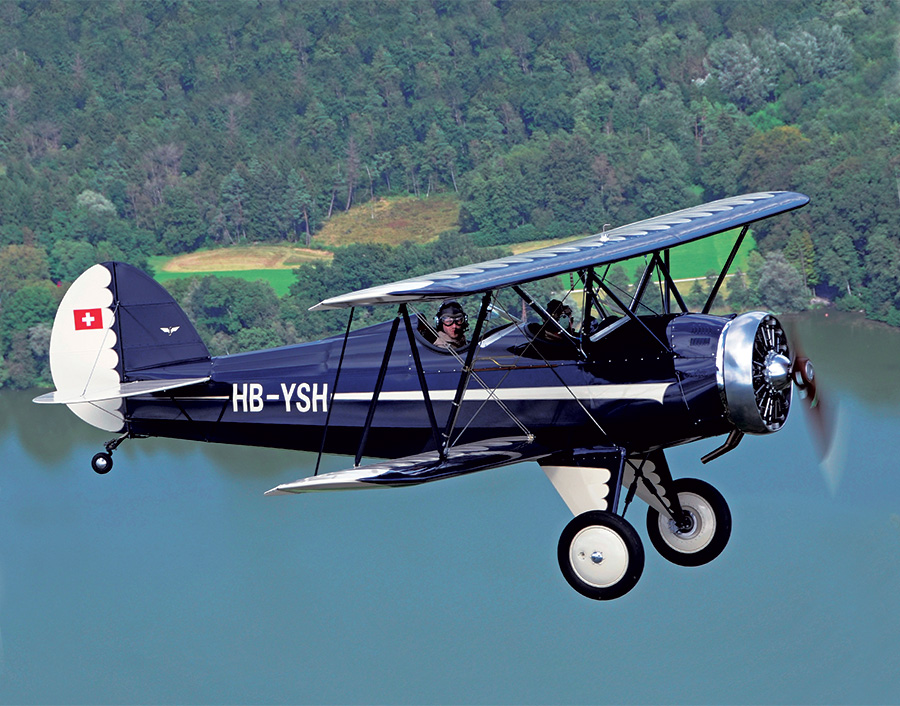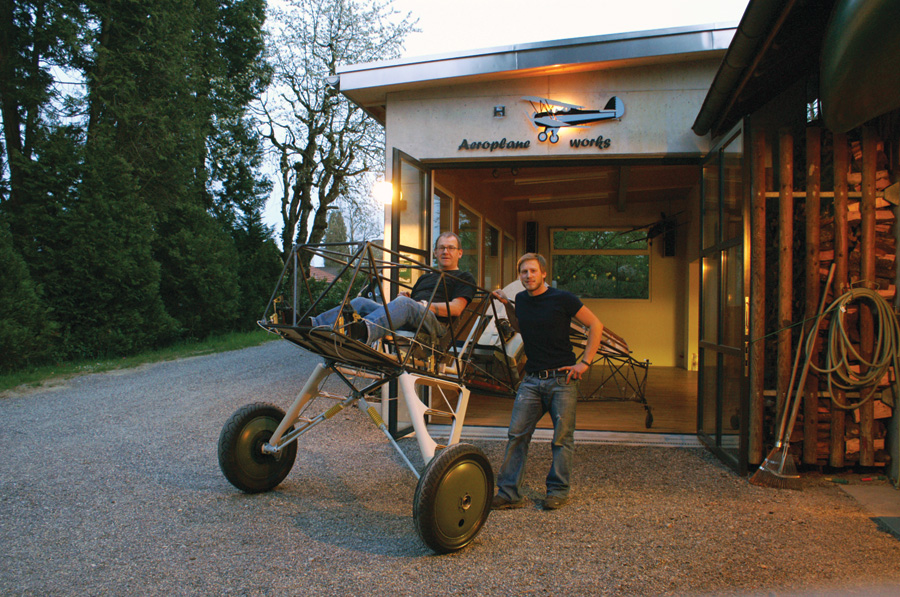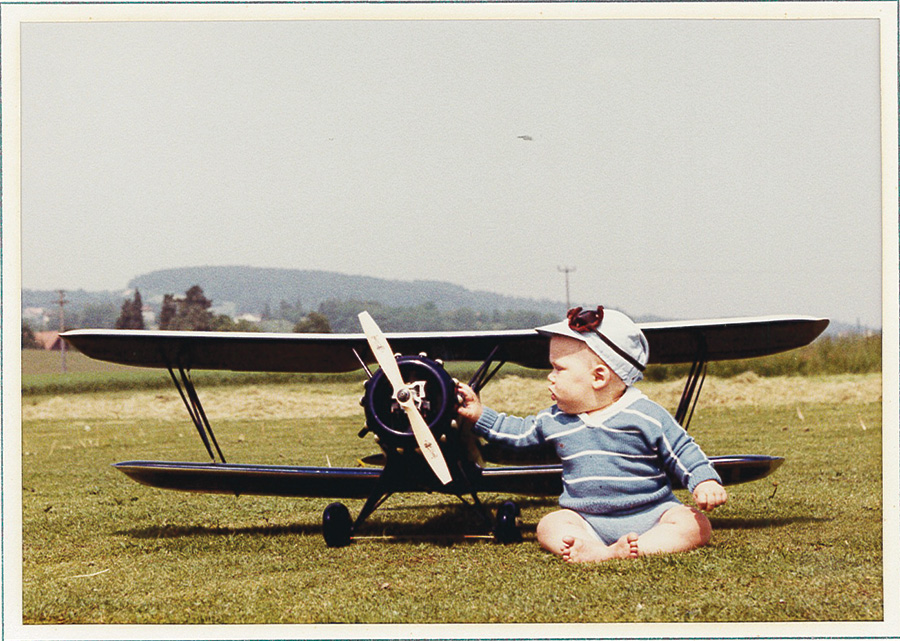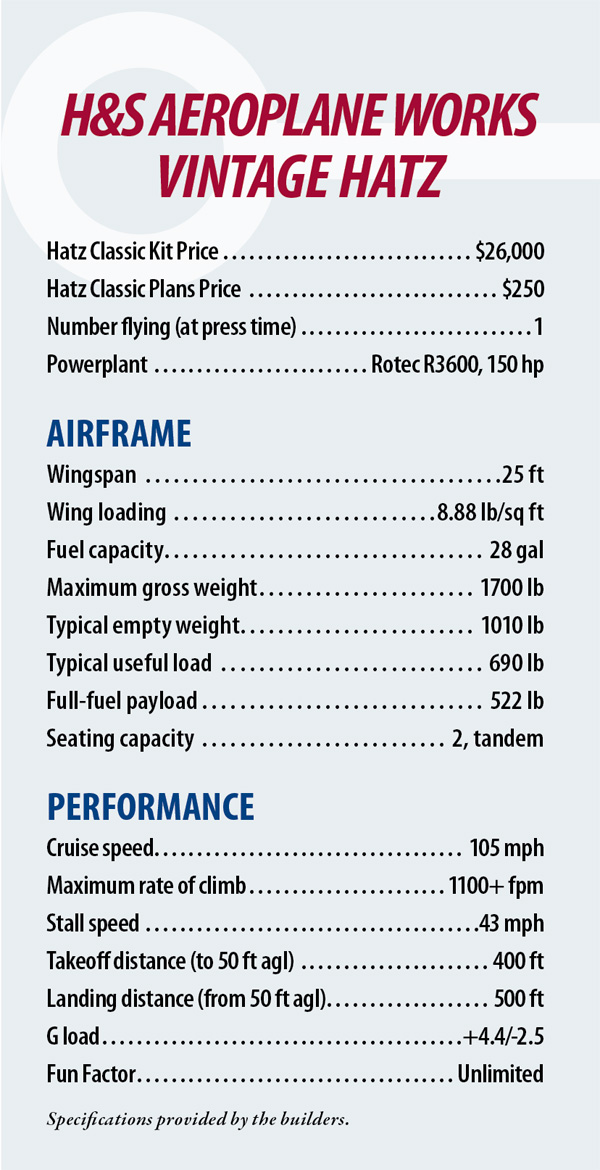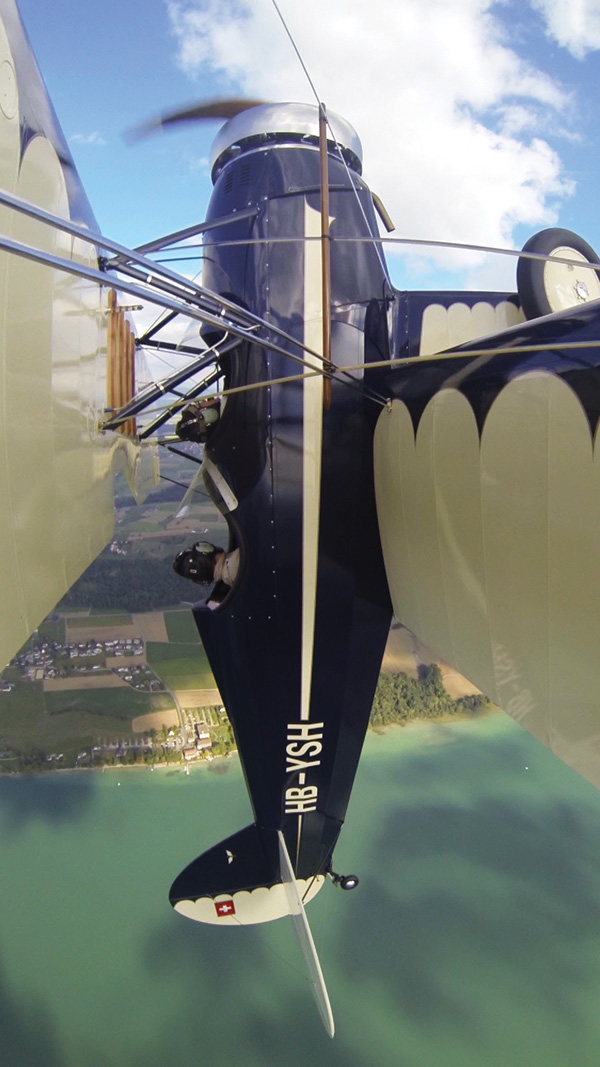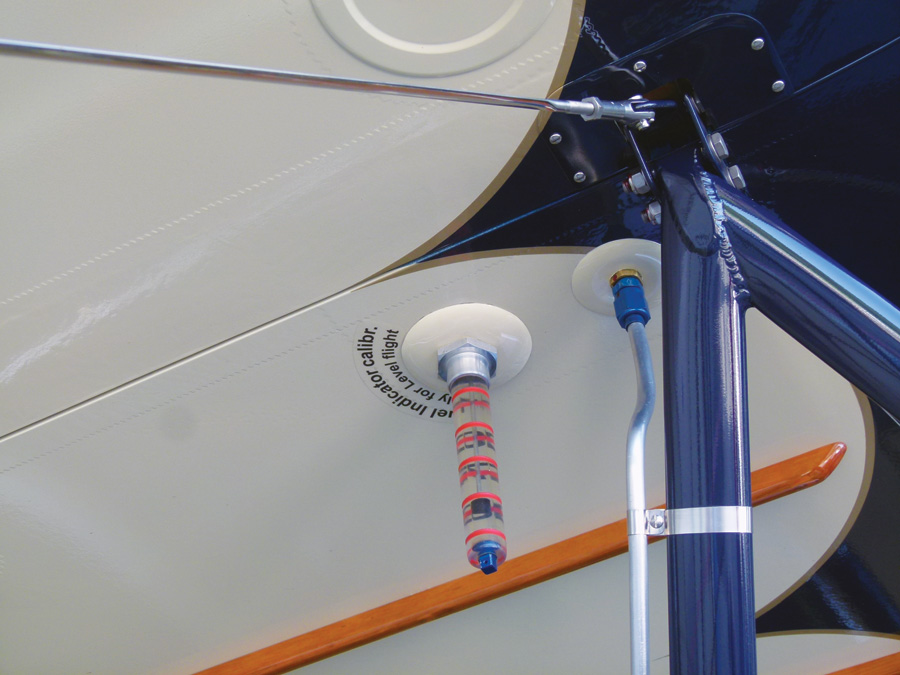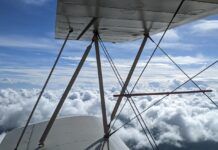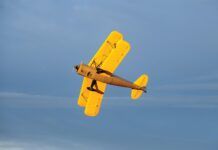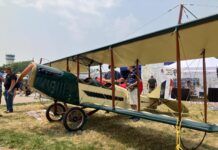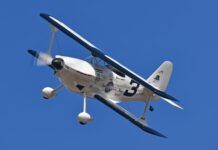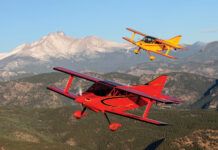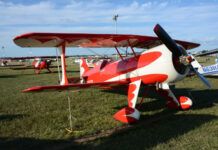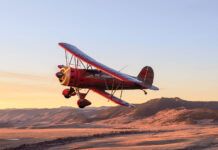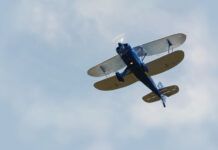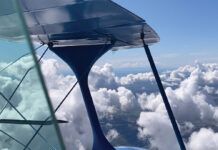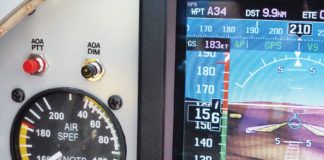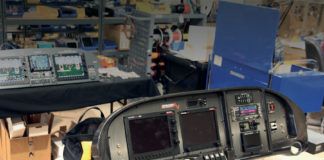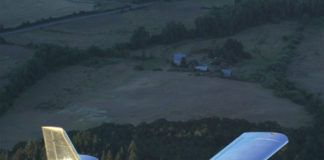I look up against the morning sun, barely able to contain myself. It’s still early at Langenthal Airfield in Switzerland, and I have an appointment to meet someone. Then I see and hear the biplane I’ve been waiting for. Just the faraway silhouette and light hum of the engine make my heart beat a little faster.
After an impressive flyover, the machine enters the pattern and lands. As it slowly motors over to the parking area, all eyes turn toward the plane. The closer it comes, the bigger my eyes get. The details become clearer, and I admire the degree of perfection to which the machine is built. The sound of the nine-cylinder radial engine rings through my entire body. The aural and visual sensations bring me to a sense of euphoria. There it finally stands before me—a masterpiece that I have been following since its inception. It has a certain radiance from the last century, the glory days of the American radial-engine biplane.
The airplane parks, and for a moment everything is still. Then the pilot, Samuel Gautschi, releases the seat belt and lifts himself out of the cockpit. Everything he wears fits the vintage style of the biplane: brown overalls, white scarf, leather aviator helmet, and flying goggles. He then helps his passenger out of the front seat. This time, it’s his mother Therese who is the lucky one to enjoy the flight, surely a good feeling, since she knows it took 10 years for her husband and son to build the airplane.
Samuel greets me enthusiastically; we haven’t seen each other in a few years. My wife and I first met Samuel and his father Hansueli at the Frankfurt Airport in 2005. We were waiting for the same plane to take us to AirVenture. Any flying enthusiast who hasn’t been to Oshkosh really needs to go.
As we flew across the Atlantic, Hansueli and Samuel told us about their shared life dream, a father-and-son project of building a ’30s-style Hatz biplane. Ever since he was a little boy, Hansueli had been building scale models of planes, preferably old-timers. Later on, he became a pilot and flew taildraggers like the Piper L-4. As family life beckoned, flying took a backseat, but the prospect of building a real plane was always in the back of his mind.
It was Samuel who eventually brought the idea back to life. Like his father, he has always had an interest in aviation, having made his first flight in a Luscombe 8F when he was just 11 years old. He was never really interested in building models, so when he asked his father one day, “Can you imagine if we built a real airplane together?” Hansueli was very surprised. He was also all in.
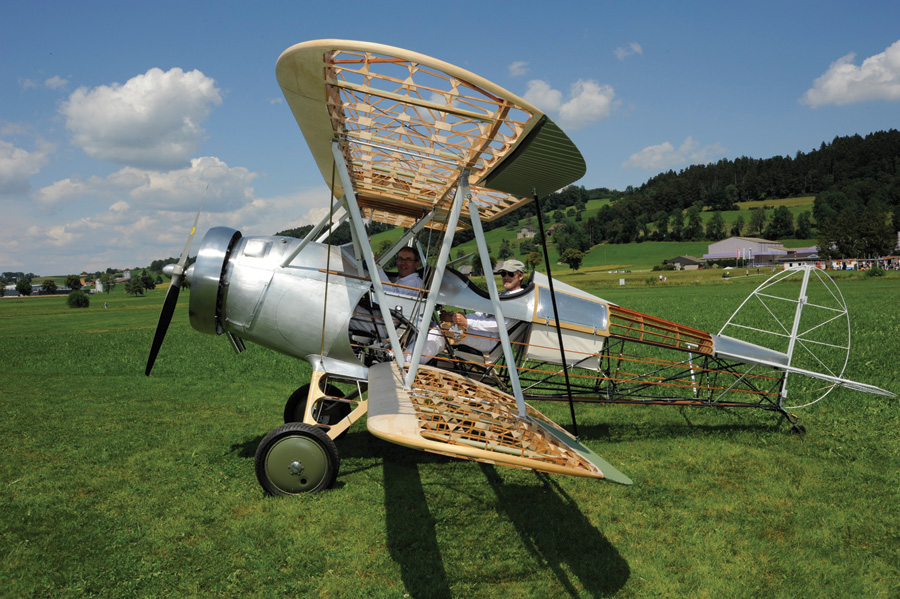
Hansueli and Samuel show off the Vintage Hatz before covering the fuselage and wings with the Poly-Fiber system.
Deciding What to Build
A trip to England allowed the father and son team to visit the centers of the old-time aeroplane scene, the museums in Hendon, Old Warden, and Duxford. They were greatly inspired by specialty restorer Retrotec Ltd. and Guy Black’s Hawker restoration. But most impressive of all was the work of Ron Sauch, a specialist near Southampton, who focuses on de Havilland Moths.
Excited by the visit to Ron, the team set their eyes on the Gipsy Moth. This plan had to be abandoned, however, due to a general veto by the English Moth Club, which frowns on replicas of the old design. If the Gautschis wanted to build a Gipsy Moth, flights into England would not be possible.
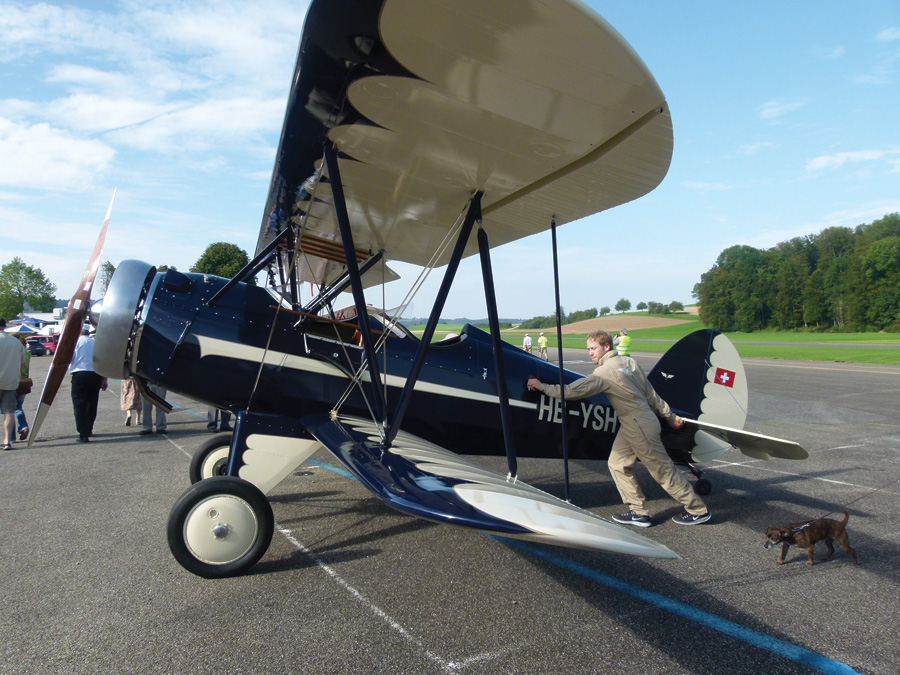
What a beauty! Workmanship and color scheme of the Hatz Classic are reminiscent of a Waco QCF from the ’30s.
Next, Hansueli and Samuel looked into the Hatz biplane. John Hatz designed the Hatz CB-1 in the 1960s, in Wisconsin. His goal was to give amateur plane builders a more affordable alternative to the very expensive Waco. Plans for the CB-1 are available from the Hatz Biplane Association, and there are more than 150 examples of the Hatz flying in the U.S.
In the mid-1990s, Billy Dawson of Texas built a modified version of the Hatz that was named plansbuilt Grand Champion at Oshkosh in 1997. This design became known as the Hatz Classic, and plans and kits are available from Makelan Corporation. Among the many changes to the original CB-1 is the outward appearance. The Hatz Classic is more rounded and full, similar to the biplanes of the 1930s.
Hansueli and Samuel decided to build a Hatz Classic. They intended to only stray from the plans by making subtle changes that would make the completed project a more realistic representation of aircraft from the nostalgic past. However, one modification was hardly subtle—they wanted a radial engine, not a typical horizontally opposed engine that powers most of the Hatz fleet.
There was also another reason for choosing the Hatz Classic. J rg M ller, a Swiss aircraft structural engineer and member of EAS (Experimental Aviation of Switzerland), had already built one, and he had made all the strength calculations. In Switzerland and Germany, this is a requirement for later single admissions of Experimental planes.
Visiting the States
Our paths diverged when we deplaned in Chicago. We had purposely arrived a week before AirVenture because my wife and I wanted to drive a rental car around the U.S. for a little bit. The Swiss father and son team had a more specific goal in mind: They wanted to go to Brodhead, Wisconsin, to the yearly Hatz Fly-in.
A few days later, we met again at AirVenture, at the Rotec booth. The Australian company had a new 9-cylinder radial engine, and its 150 horsepower was the perfect amount of power for the Hatz. When Hansueli and Samuel heard a plane with a Rotec approaching, everything for them became clear. They signed the contract for the R3600 that same day.
Hansueli later told me that the radial engine was the icing on the cake and exactly what he had in mind. “I would like to beguile the observer a little bit,” he admitted. “With the first impression, they should think they are looking at a Waco QCF.”
The Gautschis visited Oshkosh and the Hatz Fly-in in Brodhead again in 2008 and 2011, staying in close contact with the Hatz community in the U.S. for any inspirations or suggestions during the building process.
Making Steady Progress
We saw each other again in 2010 at the Swiss Air Force Live Fire Event in Axalp. I also visited the Gautschis at their home in Beinwil am See, about an hour west of Z rich. I was amazed upon arrival—big windowpanes in the attic give a direct view to the workshop, a sight that would make any amateur airplane builder’s blood rush.
The image of the still skeletal fuselage and wings inside the shop were quite a sight to behold. A sign that says “Aeroplane Works” hangs from the entrance door. And then there are all the specialty machines inside the workshop, some of which are self built for any kind of work with wood or metal. This does not look like the workshop of a hobbyist; it is more like that of a professional specialty manufacturer for individual plane construction.
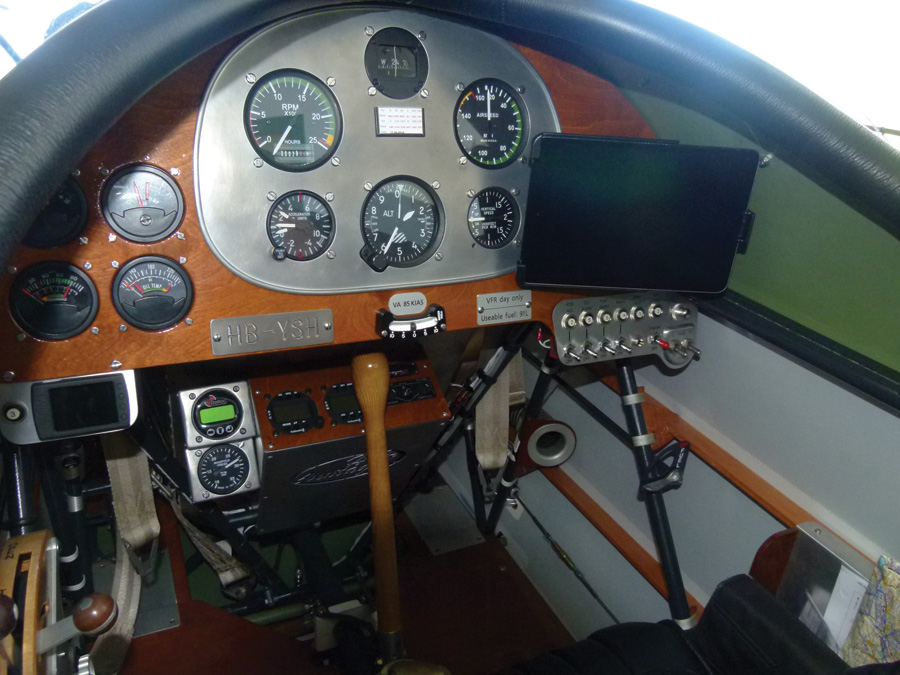
For a vintage look, steam gauges fill the panel. The iPad, which is used for navigation, is removable.
Hansueli admitted that the professional atmosphere was intentional, just in case they find a demand for custom-built airplanes, after they finish the first one. To accommodate both their current project and any potential future ones, they completely rebuilt the attic of their house. This was certainly a compromise, especially for Hansueli’s wife Therese, who supported the project wholeheartedly, in exchange for a terrace equipped with a whirlpool bath.
I sat in the cockpit and really felt how the project is the realization of a lifelong dream. Through the pilot’s windshield, I saw a photo hanging on the wall. It was an image of a tiny Samuel sitting in front of a biplane model made by his father. The mini Waco is almost bigger than the toddler. The picture made it clear to me how the passion for a biplane was passed down from father to son.
For the next few years, I followed the developments from afar. In July of 2011, Hansueli and Samuel celebrated the first outing of the fuselage at their base airport, Berom nster. In 2012, they conducted a successful strength test of the wings. Eventually they covered the fuselage and wings with the Poly-Fiber system. Hansueli meticulously researched the history of biplanes, hence the coloration; the night blue and light ivory combination, cut through with a thin gold line, harks back to an early color scheme.
Samuel was the experienced technician of the team, who in 2013 tackled the installation of the fuselage, wings, engine, and electronics. The licensing procedure was followed and controlled by the EAS.
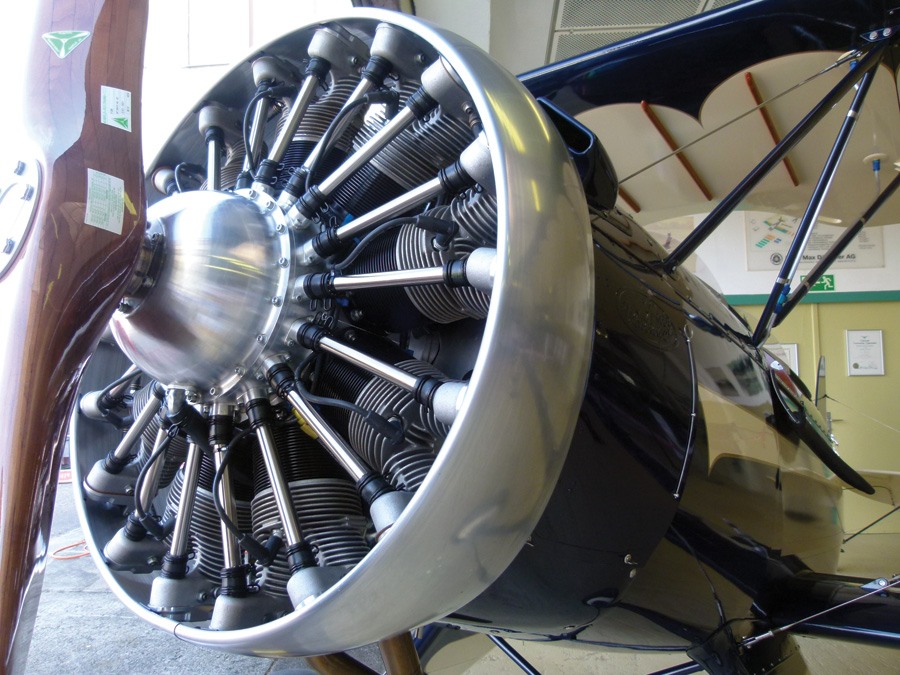
Real Waco QCFs have radial engines; to replicate the look, Hansueli and Samuel installed a nine-cylinder Rotec R3600 in the Vintage Hatz.
Success!
In 2014 I received the following email: “Hello Ernst! Samuel successfully finished the first flight of our Vintage Hatz on the afternoon of June 11th. It flies beautifully!”
That day, Hansueli watched proudly, if somewhat nervously, from the ground. Samuel had only gotten his pilot’s license during the construction of the plane, after which he had quickly gained experience in several tailwheel planes like the Piper J-3, PA-18, Husky, and above all the B cker Jungmann, which is the most similar to the Hatz.
I experienced the final product for the first time when we met at the Langenthal airport. Unfortunately, I’m not allowed to fly with them, as they’re still figuring out permit issues. I can therefore only report some of Samuel’s impressions: “The machine has harmonious flight characteristics. It is easy to maneuver and well tempered. Even with power off, it only sinks a little toward the nose, without suddenly tipping off to the side.”
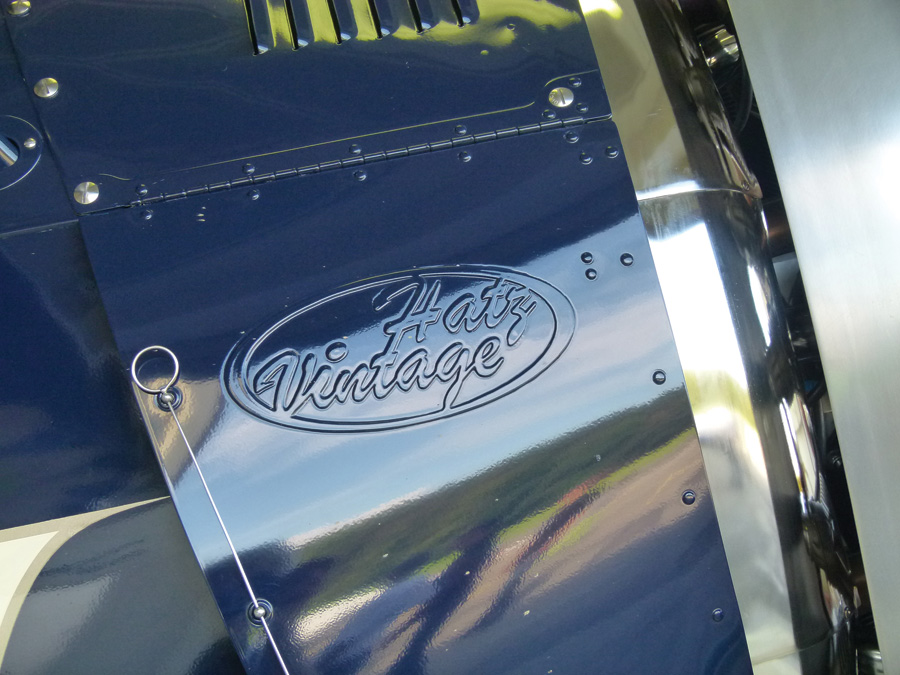
Virtually everything on the Hatz is made by the Gautschis. The attention to detail makes this a truly impressive plane.
“We did a good job finding the balance point during the construction,” said Samuel. “It’s perfect, which is particularly important for aerobatics. Typical cruising speed is 95mph, but the Hatz isn’t known for fast flying; it’s all about enjoying the open cockpit.”
Hansueli and Samuel continued describing other details. For example, there are 24-inch wheels that contribute a lot of character to the plane. The Bendix rims are the last manufactured pair made in the U.S. and were found in California. After a long search, they found the matching Harley-Davidson motorcycle high-pressure tires. Hansueli spent countless hours on the lathe, shaving the profile down to achieve its classic look.
The Gautschis rarely used standard parts, so virtually everything is self-made, including the air filter and oil and fuel tanks. The latter were originally supposed to be constructed from aluminum but were built with carbon fiber to save weight. Wherever possible, they tried to use modern parts without tarnishing the historical elements of the plane.
Samuel tells a story of an ultimate test of his patience when he was building the exhaust casing. He had to form an aluminum sheet into a three-dimensional shape, over a wooden form on a spinning lathe. A half-year of practice and over 10 unsuccessful attempts later, he finally made it. With each failed attempt, when the sheet ripped again, he had already been working for 10 or 12 hours.
Samuel also sewed his own mail pouch for storage, custom fit and stored in the fuselage behind the pilot’s seat. “It is just like those used by old mail aviators and barnstormers,” he explained.
One of the only exceptions to the vintage look of the airplane is an iPad in the cockpit that is used for navigation. Fortunately, it is removable.
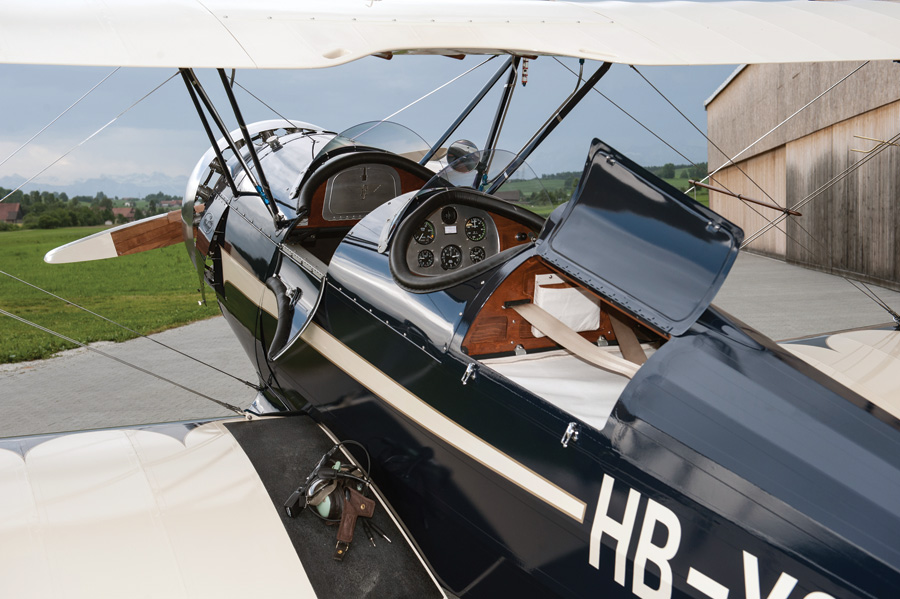
A round engine, two cockpits, and room for baggage—does it get any better than this in the biplane world?
Flying Upside Down
In June 2015 my wife and I received another email from Hansueli: “Can you imagine—we’re allowed to perform gentleman’s aerobatics!” It turned out that Samuel was learning basic maneuvers like loops, barrel rolls, and Immelmann turns from Matthias Glutz, an experienced aerobatics pilot.
On July 1, 2015, Hansueli and Samuel’s Hatz Classic, with aircraft registration number HB-YSH, was licensed for aerobatics and regular flights outside of Switzerland by BAZL (the Federal Office of Civil Aviation, FOCA). That means I can hope the plane will make some appearances on airfields throughout Germany.
Since then, Samuel has earned his aerobatics rating and will likely make many more appearances at airshows and vintage aircraft events. The Hatz has already won awards for design and quality of construction from the EAS. And a flight to England is in the works, a commemoration to the memorable father-and-son trip of 2004.
Throughout the 10-year build, father and son maintained complete unity. They thoroughly enjoyed the time they spent together developing, constructing, and overcoming obstacles big and small. They already miss the challenge of the project and would like to build another Hatz Classic just like it—or maybe two or three, provided there’s demand on the market.
For more information, visit www.aeroplaneworks.ch.


